See my, “Is Jesus a Copycat Savior?“, for more.
PURCHASE THE BOOK, it is a must for a Christian scholars library: Amazon | LOGOS
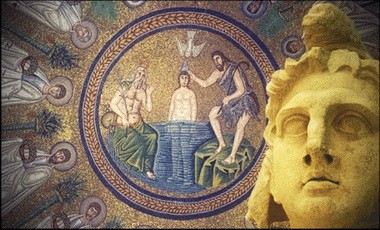
See my, “Is Jesus a Copycat Savior?“, for more.
PURCHASE THE BOOK, it is a must for a Christian scholars library: Amazon | LOGOS

(Originally Posted July of 2010)
CRI’s EQUIP post has a short list to make the point:
A Common Flood Story. Not just the Hebrews (Gen. 6–8), but Mesopotamians, Egyptians, and Greeks all report a flood in primordial times. A Sumerian king list from c. 2100 BC divides itself into two categories: those kings who ruled before a great flood and those who ruled after it. One of the earliest examples of Sumero-Akkadian-Babylonian literature, the Gilgamesh Epic, describes a great flood sent as punishment by the gods, with humanity saved only when the pious Utnapishtim (AKA, “the Mesopotamian Noah”) builds a ship and saves the animal world thereon. A later Greek counterpart, the story of Deucalion and Phyrra, tells of a couple who survived a great flood sent by an angry Zeus. Taking refuge atop Mount Parnassus (AKA, “the Greek Ararat”), they supposedly repopulated the earth by heaving stones behind them that sprang into human beings.
The Code of Hammurabi. This seven-foot black diorite stele, discovered at Susa and presently located in the Louvre museum, contains 282 engraved laws of Babylonian King Hammurabi (fl. 1750 BC). The common basis for this law code is the lex talionis (“the law of the tooth”), showing that there was a common Semitic law of retribution in the ancient Near East, which is clearly reflected in the Pentateuch. Exodus 21:23–25, for example, reads: “But if there is serious injury, you are to take life for life, eye for eye, tooth for tooth, hand for hand, foot for foot…” (niv).
The Nuzi Tablets. The some 20,000 cuneiform clay tablets discovered at the ruins of Nuzi, east of the Tigris River and datable to c. 1500 BC, reveal institutions, practices, and customs remarkably congruent to those found in Genesis. These tablets include treaties, marriage arrangements, rules regarding inheritance, adoption, and the like.
The Existence of Hittites. Genesis 23 reports that Abraham buried Sarah in the Cave of Machpelah, which he purchased from Ephron the Hittite. Second Samuel 11 tells of David’s adultery with Bathsheba, the wife of Uriah the Hittite. A century ago the Hittites were unknown outside of the Old Testament, and critics claimed that they were a figment of biblical imagination. In 1906, however, archaeologists digging east of Ankara, Turkey, discovered the ruins of Hattusas, the ancient Hittite capital at what is today called Boghazkoy, as well as its vast collection of Hittite historical records, which showed an empire flourishing in the mid-second millennium BC. This critical challenge, among many others, was immediately proved worthless — a pattern that would often be repeated in the decades to come.
The Merneptah Stele. A seven-foot slab engraved with hieroglyphics, also called the Israel Stele, boasts of the Egyptian pharaoh’s conquest of Libyans and peoples in Palestine, including the Israelites: “Israel — his seed is not.” This is the earliest reference to Israel in nonbiblical sources and demonstrates that, as of c. 1230 BC, the Hebrews were already living in the Promised Land.
Biblical Cities Attested Archaeologically. In addition to Jericho, places such as Haran, Hazor, Dan, Megiddo, Shechem, Samaria, Shiloh, Gezer, Gibeah, Beth Shemesh, Beth Shean, Beersheba, Lachish, and many other urban sites have been excavated, quite apart from such larger and obvious locations as Jerusalem or Babylon. Such geographical markers are extremely significant in demonstrating that fact, not fantasy, is intended in the Old Testament historical narratives; otherwise, the specificity regarding these urban sites would have been replaced by “Once upon a time” narratives with only hazy geographical parameters, if any.
Israel’s enemies in the Hebrew Bible likewise are not contrived but solidly historical. Among the most dangerous of these were the Philistines, the people after whom Palestine itself would be named. Their earliest depiction is on the Temple of Rameses III at Thebes, c. 1150 BC, as “peoples of the sea” who invaded the Delta area and later the coastal plain of Canaan. The Pentapolis (five cities) they established — namely Ashkelon, Ashdod, Gaza, Gath, and Ekron — have all been excavated, at least in part, and some remain cities to this day. Such precise urban evidence measures favorably when compared with the geographical sites claimed in the holy books of other religious systems, which often have no basis whatever in reality.10
Shishak’s Invasion of Judah. First Kings 14 and 2 Chronicles 12 tell of Pharaoh Shishak’s conquest of Judah in the fifth year of the reign of King Rehoboam, the brainless son of Solomon, and how Solomon’s temple in Jerusalem was robbed of its treasures on that occasion. This victory is also commemorated in hieroglyphic wall carvings on the Temple of Amon at Thebes.
The Moabite Stone. Second Kings 3 reports that Mesha, the king of Moab, rebelled against the king of Israel following the death of Ahab. A three-foot stone slab, also called the Mesha Stele, confirms the revolt by claiming triumph over Ahab’s family, c. 850 BC, and that Israel had “perished forever.”
Obelisk of Shalmaneser III. In 2 Kings 9–10, Jehu is mentioned as King of Israel (841–814 BC). That the growing power of Assyria was already encroaching on the northern kings prior to their ultimate conquest in 722 BC is demonstrated by a six-and-a-half-foot black obelisk discovered in the ruins of the palace at Nimrud in 1846. On it, Jehu is shown kneeling before Shalmaneser III and offering tribute to the Assyrian king, the only relief we have to date of a Hebrew monarch.
Burial Plaque of King Uzziah. Down in Judah, King Uzziah ruled from 792 to 740 BC, a contemporary of Amos, Hosea, and Isaiah. Like Solomon, he began well and ended badly. In 2 Chronicles 26 his sin is recorded, which resulted in his being struck with leprosy later in life. When Uzziah died, he was interred in a “field of burial that belonged to the kings.” His stone burial plaque has been discovered on the Mount of Olives, and it reads: “Here, the bones of Uzziah, King of Judah, were brought. Do not open.”
Hezekiah’s Siloam Tunnel Inscription. King Hezekiah of Judah ruled from 721 to 686 BC. Fearing a siege by the Assyrian king, Sennacherib, Hezekiah preserved Jerusalem’s water supply by cutting a tunnel through 1,750 feet of solid rock from the Gihon Spring to the Pool of Siloam inside the city walls (2 Kings 20; 2 Chron. 32). At the Siloam end of the tunnel, an inscription, presently in the archaeological museum at Istanbul, Turkey, celebrates this remarkable accomplishment. The tunnel is probably the only biblical site that has not changed its appearance in 2,700 years.
The Sennacherib Prism. After having conquered the 10 northern tribes of Israel, the Assyrians moved southward to do the same to Judah (2 Kings 18–19). The prophet Isaiah, however, told Hezekiah that God would protect Judah and Jerusalem against Sennacherib (2 Chron. 32; Isa. 36–37). Assyrian records virtually confirm this. The cuneiform on a hexagonal, 15-inch baked clay prism found at the Assyrian capital of Nineveh describes Sennacherib’s invasion of Judah in 701 BC in which it claims that the Assyrian king shut Hezekiah inside Jerusalem “like a caged bird.” Like the biblical record, however, it does not state that he conquered Jerusalem, which the prism certainly would have done had this been the case. The Assyrians, in fact, bypassed Jerusalem on their way to Egypt, and the city would not fall until the time of Nebuchadnezzar and the Neo-Babylonians in 586 BC. Sennacherib himself returned to Nineveh where his own sons murdered him.
The Cylinder of Cyrus the Great. Second Chronicles 36:23 and Ezra 1 report that Cyrus the Great of Persia, after conquering Babylon, permitted Jews in the Babylonian Captivity to return to their homeland. Isaiah had even prophesied this (Isa. 44:28). This tolerant policy of the founder of the Persian Empire is borne out by the discovery of a nine-inch clay cylinder found at Babylon from the time of its conquest, 539 BC, which reports Cyrus’s victory and his subsequent policy of permitting Babylonian captives to return to their homes and even rebuild their temples.
So it goes. This list of correlations between Old Testament texts and the hard evidence of Near Eastern archaeology could easily be tripled in length….
Bible Reliability 3: Archeological Discoveries
Here are some older posts/conversations:
This story has an important facet for us apologists, but first, let us enjoy this finds belated attribution:
Jerusalem Post: Long time archaeological riddle solved
The riddle of the identity of a 3,200-year-old round bronze tablet with a carved face of a woman has apparently been solved, 13 years after it was discovered at the El-ahwat excavation site between Katzir-Harish and Nahal Iron (Wadi Ara) by scientist Oren Cohen of the University of Haifa.
The small, broken-off piece of metal is probably part of a linchpin that held the wheel to a war chariot sent to battle by the Canaanite general Sisera against the Israelites, says Prof. Adam Zertal, who for 33 years has led weekly walks with university colleagues and volunteers over “every square meter” of Samaria and the Jordan Rift to search for archeological evidence from biblical times.
The round, bronze tablet, about 2 centimeters in diameter and 5 millimeters thick, features a carved face of a woman wearing a cap and earrings shaped as chariot wheels. It was found in a structure identified as the “Governor’s House.”
Cohen was unable to find its parallel in any other archeological discoveries. When carrying out a study on the walls of the Temple of Rameses III in Egypt of ancient reliefs depicting chariot battles, Cohen identified a unique decoration – the bronze linchpins fastening the chariot wheels were decorated with the faces of captives, foreigners and enemies of Egypt. He also noticed that these decorations characterized those chariots that were used by royalty and other dignitaries. Cohen found that the linchpin with the woman’s face found near Katzir was almost identical to that found in the Egyptian temple.
The identification as a linchpin, Zertal said, reinforces the claim that a high-ranking Egyptian or local ruler was based at this location and is likely to support the theory that the site is Haroshet Hagoyim – the Canaanite base of Sisera, as mentioned in the fourth and fifth chapter of the Book of Judges, the 70-year archeologist told The Jerusalem Post on Thursday.
The Egyptians and Canaanites both created linchpins for chariots with the carved faces of their enemies; the place on the wheels were considered “very undignified,” said Zertal, like the Jews putting Haman’s name on the soles of their shoes for beating against the floor while the Book of Esther is read aloud…
…Sisera was the captain of the army of Yavin, king of Canaan. According to Judges 4:3, Sisera led an army of 900 iron chariots and oppressed the Israelites for two decades. Deborah the Prophetess, then leader of the Israelite tribes, persuaded Barak to face Sisera in battle. He led a force of 10,000 and destroyed the army of Sisera, whose origin was completely unknown. The battle, the Bible says, led to a 40-year peace…
…The Haifa archeologist was raised at a Hashomer Hatzair kibbutz and severely wounded in the Yom Kippur War. “I spent a year at Hadassah Hospital in Jerusalem, and I became interested in archeology. Although I had argued that the Bible was full of myths, I decided after my recovery to travel the land by foot to look for archeological evidence.”
Zertal, who took the walks often using crutches from his decades-old injury, added: “I am a man of science and have to investigate whether what is described in the Bible suits the geography. Nobody thought there was an altar on Mount Ebal, but the evidence was found. It is not a legend. When you do archeological research as you should, you see a lot [of the biblical stories] is reality.”
…(read more)…
This last part is key, let me explain. Archaeology has served as one of the great evidences for the skeptical person to have many of their doubts answered. I wish to display the above in some past debates I have had. Since many of these past debates are about a decade old or older, referencing isn’t up to my current par… but you will get the main point of the discussions at hand. Also keep in mind these are portions of larger responses… so you may feel like you just stepped into the middle of a conversation – you would be right.
The first presentation is a discussion between myself and Rocket Girl, the second between myself a Nightmyre.
Discussion with Rocket Girl
Rocket Girl made reference to where the evidence for Noah’s Flood is, Sodom and Gomorrah (here is an article, see video as well), and the like. I respond:
People use to say the same about David, Saul, Solomon. The Bible makes mention of the Hittites 47 times… people use to say “where is the evidence for these peoples? It must be a myth!” As with David, Saul, and the many others once thought to be mythical, all have been found. In fact, Turkey has a museum dedicated solely to the Hittite peoples.
Rocket Girl mentioned wanting proof for Noah’s Ark. This proof would also require evidence for a worldwide flood, and keeping this short and sweet, over 75% of the earth’s crust is sediment – that is, the matter that settles to the bottom of a liquid; lees; dregs (Webster). That’s a lot of proof of water at some point in earth’s history. Over 220 cultures (from the Australian Aboriginal to the South American Indian to the Russians and Chinese) separated by time and water all have stories of the first man being red (Hebrew for Adam means red clay), a worldwide flood, a bird being released after the craft landed, and an animal sacrifice, etc.
It seems funny that one would ask for evidence of Sodom and Gomorrah, as this town has been found. There are writings from antiquity (other than Biblical) about it as well as the excavation of Bab edh-Dhra. The writings of Nebuchadnezzar speak of the world having one language and all living around a great tower that he tried to rebuild (that Saddam Hussein is rebuilding as well). Man-made items found in most geological layers (even the pre-Cambrian). Dinosaur boned found by riverbeds so fresh at first they thought to be Bison bones. T-Rex blood found in an un-mineralized bone. As well as dino bones found with blood cells and proteins. Ancient stone work of Dinosaurs, Etc., Etc.
Sir Frederic Kenyon, former director and principle librarian of the British Museum, was possibly the most respected New Testament textual scholar in our century. Shortly before his death he commented on the significance of the fact that the evidence is overwhelming that the Gospels were composed shortly after the events of Christ’s life and that the early church widely distributed them within its congregations within a relatively short period of time is significant. Kenyon wrote:
“the interval, then, between the dates of the original composition and the earliest extant evidence becomes so small as to be in fact negligible, and the last foundation for any doubt that the Scriptures have come down to us substantially as they were written has now been removed. Both the authenticity and the general integrity of the books of the New Testament may be regarded as finally established.”
After a lifetime of in-depth review of the New Testament manuscripts, Kenyon concluded that the present text in our Bible is absolutely reliable. He wrote: “It is reassuring at the end to find that the general result of all these discoveries and all this study is to strengthen the proof of the authenticity of the Scriptures, and our conviction that we have in our hands, in substantial integrity, the veritable Word of God.”
Dr William F. Albright was unquestionably one of the world’s most brilliant Biblical archaeologists. In 1955 he wrote: “We can already say emphatically that there is no longer any solid bases for dating any book of the New Testament after circa A.D.80.” He was a skeptic! However, over the next several decades of discoveries were convincing enough to make him pen this on the New Testament being written: “probably sometime between circa A.D.50 and 75.” Albright concluded, from the evidence, that the writing of the New Testament within a few years of the events of Christ’s life and the writing was “too slight to permit any appreciable corruption of the essential center and even of the specific wording of the sayings of Christ.” In other words, Professor Albright, one of the greatest minds in the field of archaeology and ancient texts, concluded (via evidence) that the New Testament records the truth about Jesus Christ and His statements.
Dr. John A.T. Robinson was a distinguished lecturer at Trinity College, Cambridge and developed a reputation as a great scholar. Naturally, he accepted the academic consensus universally held since 1900, that denied the disciples and Paul wrote the New Testament and concluded that it was written up to a hundred years after Christ. However, an article in Time magazine, March 21, 1977, reported that Robinson decided to personally investigate for himself the arguments behind this scholarly “consensus” against the New Testament’s reliability because he realized that very little original research had been completed in this field in this century. He was shocked to discover that much of past scholarship against the New Testament was untenable because it was based on a “tyranny of unexamined assumptions” and what he felt must have been an “almost willful blindness.”
To the amazement of his university colleagues, Robinson concluded that the apostles must have been the genuine writers of the New Testament books in the years prior to A.D.64. He also noted that if you were to reject the evidence of the before mentioned research and throw out the conclusions of original authorship of the New Testament. You would also have to throw out every ancient writing of antiquity as well as historical writings of recent and ancient origin.
Some More
Archaeological Discoveries have done nothing but fortify the Gospels and the events in them. The New Testament alone has over 25,000 archaeological sites alone, and every turn of the archaeologists spade reveals one more truth of the evidences of faith. Not one prophecy, historical fact, archaeological, or scientific find about (or in) the bible has been shown to be wrong.
Dr. Nelson Gleuck, president of Hebrew Union College and the leading Palestinian archaeologist of the twentieth century said: “it may be stated categorically that no archaeological discovery has ever controverted a Biblical reference. Scores of archaeological findings have been made which confirm in clear outline or in exact detail historical statements in the Bible.”
William Ramsay, the English scholar, traveled as a young man to Asia Minor over a century ago for the sole purpose of disproving the Bible’s history as described by Luke in his Gospel and in the book of Acts. Ramsey and his professors were convinced that the New Testament record must be terribly inaccurate. He believed that Luke could not be correct in his history of Christ or in his account about the growth of the Church during the first decades following Christ. Dr. Ramsay began digging in the ancient ruins of sites throughout Greece and Asia Minor, searching for ancient names, boundary markers, and other archaeological finds that would conclusively prove that Luke had invented his history Christ and His Church. To his amazement and dismay, William Ramsay discovered that the statements of the New Testament Scriptures were accurate in the smallest detail. Finally, Dr. Ramsay was convinced by the overwhelming evidence proving the Bible’s accuracy. Consequently, he accepted Jesus Christ as his personal Savior (based on the evidence alone).
A.N. Sherwin-White, was a great (some say the greatest historian of Roman life, history, and culture) classical historical scholar at Oxford University who studied the extensive evidence for and against the historical accuracy of the Book of Acts. Sherwin-White wrote his conclusion after studying the evidence: “For Acts the confirmation of historicity is overwhelming… any attempt to reject its basic historicity even in matters of detail must now appear absurd.”
Discussion with Nightmyre
Nightmyre, you said:
“Christianity, and many other religions, put forth the concept of Heaven and Hell. Obviously, there is no basis in REALITY for these two locations. You cannot look on a map and pinpoint the physical location of heavan and hell. However the religion gives you the TOOLS NECESSARY to reach this goal. And using these tools requires a large amount of faith, because you are NEVER certain that you will reach your goal.”
You show a very tainted view of what Christianity actually teaches. You seem to clump many beliefs (not just Christianity) into one set or way of thinking. This is not only disrespectful to me (although it really doesn’t bother me), it is disrespectful to others of various faiths. I make it a goal to, at the least, when I deal with other faiths, to really delve into what they actually teach and believe. I will post some stuff here to assist in showing you where you are off the mark in just one area of the Christian faith.
Obviously, if the God of the universe has revealed Himself and is the only true God, and if Christ is the only true way of salvation, then we would expect convincing evidence to substantiate this. Not just some evidence, or inferior evidence-so that a person has a dozen equally valid options in the choice of their religion-but superior evidence. Dr. John Warwick Montgomery asks:
“What if a revelational truth-claim did not turn on questions of theology and religious philosophy-on any kind of esoteric, fideistic method available only to those who are already “true believers” – but on the very reasoning employed in the law to determine questions of fact?… Eastern faiths and Islam, to take familiar examples, ask the uncommitted seeker to discover their truth experientially: the faith-experience will be self-validating…. Christianity, on the other hand, declares that the truth of its absolute claims rests squarely on certain historical facts, open to ordinary investigation…. The advantage of a jurisprudential approach lies in the difficulty of jettisoning it: legal standards of evidence developed as essential means of resolving the most intractable disputes in society … Thus one cannot very well throw out legal reasoning merely because its application to Christianity results in a verdict for the Christian faith.”
Dr. John Warwick Montgomery makes the point again that “the historic Christian claim differs qualitatively from the claims of all other world religions at the epistemological point: on the issue of testability” (“The Jury Returns: A Juridical Defense of Christianity,” in Evidence for Faith: Deciding the God Question, p. 319). A good example of someone taking the faith up on its claims were Viggo Olsen, M.D., author of Daktar: Diplomat in Bangladesh, and his wife, who were both skeptics who…
“decided to embark on a detailed study of Christianity with the intention of rejecting it on intellectual grounds. Little by little, as they studied works that deal with data common to apologetics and evidences… they were led step by step to see the truthfulness of Christianity. Their study was no minor investigation or causal perusal. It was an exhaustive search…” (Frederick R. Howe, The Role of Apologetics and Evangelism).
And this claim to truth includes the possibility of self-defeating constructs within the framework of Christian philosophy, which I have shown to be in the atheists philosophy. Mortimer J. Adler is one of the world’s leading philosophers, chairman of the board of editors for the Encyclopedia Britannica, architect of the Great Books of the Western World series and its remarkable Syntopicon, he is also the director of the prestigious Institute for Philosophical Research in Chicago. Adler says, “I believe Christianity is the only logical, consistent faith in the world” (Christianity Today, Nov. 19, 1990). Did you get that? One of the greatest philosophers of our time said that unlike Christianity, every religion that claims to have an epistemology is self-defeating.
Dr. Drew Trotter, a Cambridge University graduate, argues convincingly that “logic and the evidence both point to the reality of absolute truth….” George F. Gilder, one of our century’s “greatest minds,” and author of Wealth and Poverty and Telecosm, says “Christianity is true, and its truth will be discovered anywhere you look very far”] (David A. Noebel, Understanding the Times: The Religious Worldviews of Our Day and the Search for Truth, p. 13). Principle at Wycliff Hall, Alister McGrath, author of Intellectual Don’t Need God and Other Myths, says the evidence for Christianity is akin to that found in doing good scientific research:
“When I was undertaking my doctoral research in molecular biology at Oxford University, I was frequently confronted with a number of theories offering to explain a given observation. In the end, I had to make a judgment concerning which of them possessed the greatest internal consistency, the greatest degree of predictive ability. Unless I was to abandon any possibility of advance in understanding, I was obliged to make such a judgment… I would claim the right to speak of the ‘superiority’ of Christianity in this explicative sense” (“Response to John Hick,” in More Than One Way? Four Views on Salvation in a Pluralistic World, p. 68).
Noted Christian scholar Dr. Carl F. H. Henry wrote a three thousand page, six volume work on the topic of God, Revelation, and Authority. After his exhaustive [to say the least] analysis, Henry declared that “Truth is Christianity’s most enduring asset…” (Ajith Fernando, The Supremacy of Christ, p. 109).
Dr. Robert A. Morey writes,
“There is more than enough evidence on every hand from every department of human experience and knowledge to demonstrate that Christianity is true… [It is the faith of the non-Christian [that] is externally and internally groundless. They are the ones who leap in the dark. Some, like Kierkegaard, have admitted this” (Introduction to Defending the Faith, p. 38).
James Sire points out in his book, Why Should Anyone Believe Anything At All?, that an argument for belief, religious or otherwise, must be secured on the best evidence, validly argued, and able to refute the strongest objections that can be mustered against it (p. 10). Dr. Norman Geisler adds that “In the face of overwhelming apologetic evidence, unbelief becomes perverse” (Baker Encyclopedia of Apologetics, p. 529).

Yet more evidence (as if any more is needed) to show “Palestinians — as a distinct people — is fraudulent (via WND):
A dig 40 feet under a former parking lot in Jerusalem unearthed a tiny clay seal bearing the name of an aide to the biblical King Josiah.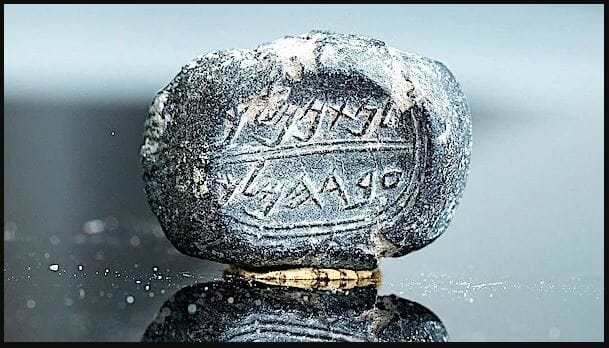
Some 2,600 years old, it bears the name of a royal official known as “Natan L’Melech,” reports the Jewish website Aish.
The Israel antiquities authority is supervising the dig, which also has yielded a blue agate stone seal known as a bulla.
It carried the inscription belonging to Ikkar son of Matanyahu, officials said.
“This is not just another discovery,” said Professor Yuval Gadot, 51, the head of archaeology at Tel Aviv University, in an interview with Aish.
He is leading the dig.
“We are talking about the cradle of civilization and a highly significant item which bears the name of a specific individual,” he said.
The report said the seal was the first archaeological evidence of the biblical name Nathan-Melech….
Also this archaeological dig discovered, for the first time, the remains of a Second Temple period Jewish settlement IN the city of Beersheva, a connection to both Abraham and Jesus (via CBN-NEWS):
…The excavations were part of a plan to facilitate a new neighborhood in the city. However, Israeli researchers inadvertently uncovered the remains of an ancient neighborhood that was once bustling with ancient Jewish life.
The site is dated from the 1st century AD until the Bar-Kokhba Revolt against the Roman Empire in 135 AD. It is located along the southern border of the ancient kingdom of Judah.
A dig 40 feet under a former parking lot in Jerusalem unearthed a tiny clay seal bearing the name of an aide to the biblical King Josiah.
[….]
“Remains of the settlement cover an area of c. 2 dunams and include several structures and installations, such as the foundations of a large watchtower, baking facilities, ancient trash pits and an underground system that was probably used as a Jewish ritual bath (mikveh),” explained Dr. Peter Fabian of the Ben-Gurion University in the Negev and Dr. Daniel Varga of the Israel Antiquities Authority.
“Signs of a conflagration discovered in some of the structures evince a crisis that the settlement experienced, probably that of the First Jewish Revolt,” they added. That revolt took place in 70 AD.
Researchers are especially excited about the ancient menorah found on the oil lamp shard.
“This is probably one of the earliest artistic depictions of a nine-branched menorah yet discovered,” Dr. Vargas said.
Archaeologists also found dozens of bronze coins that were minted by the Roman Empire.
In Genesis 21, the city was founded by Abraham and Abimelech after the two settled their differences over a well of water and formed a covenant together. The name Beersheva means “Well of Seven” or “Well of the Oath.”
The Bible says Isaac built an altar in Beersheba and Jacob had a dream about a stairway to heaven after leaving the city.
Later, the prophet Elijah took refuge in Beersheva after Jezebel ordered his execution.
Beersheva is mentioned in the Bible several times in connection with the Hebrew Patriarchs Abraham and Isaac.
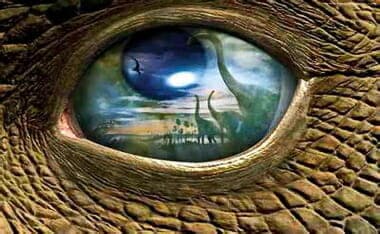
 Contents:
Contents:
I have updated the “Triceratops Horn” section, as, the Los Angeles County Superior Court Ruled against California State University Northridge (CSUN) in favor of Dr. Mak Armitage.
This will be an update to previous posts on this .com and my previous blog (BlogSpot). It will serve as a part-two-of-a-two-part discussion to young earth views that deals with evidences of mankind throughout all geological ages. While this is far from an in-depth excoriation of the evidences, it is a good introduction to some of them. I do not start off or bring up young earth creationism typically. Typically I will lead off with talking about theistic evidences [MACRO evidences for God] that assume a mainstream assumption about the age of the cosmos/earth. But the below evidences can be incorporated into a response when challenged about the topic. (See also: “Two Ways to Look At Origins;” and, “Reason and Faith.”)
As usual, all graphics are linked for further resource hunting. One may wish to visit my post on Archaeology and the Bible, which includes some responses to skeptics from a decade[+] ago.
+900yr-old Carving In the Ta Prohm Temple of Angkor Wat
This was part of a larger post/blog I did entitled, “Dinosaurs, the Bible, and Creation Proofs.” After a discussion with a fellow believer I wanted to get this video isolated here and it is included in my “Must See Videos” section in the left-hand column. With that small intro, here it is:
The above videos are one OF MANY evidences that humankind at one point may have seen dinosaurs… more evidence exists that just what I am providing here, but the above is one of the clearest examples of not just ancients finding bones, but see skin, muscle, and eyes of a stegosaurus.
Tyrannosaurus (T-Rex) Blood Cells & Protein 
By using immunological tests, Gerard Muyzer of Leiden University in the Netherlands, isolated samples from some fresh T-Rex bone that had a specific bone protein (osteocalcin) in them. These proteins, reported in Geology magazine (Oct. 1992), are very unstable, and cannot last for very many years once the creature who carries them dies [perm-a-freeze cannot account for the longevity evolution gives to these proteins]. The photo [right] is a newer find where malleable flesh and intact blood cells are throughout. H/t to The Pearcey Report for this story from WND that keeps evolving:
Paleontologist Mary Schweitzer of North Carolina State University first claimed to have isolated soft tissues and collagen from a Tyrannosaurus rex leg bone several years ago.
But because the leg was broken during excavation, the evidence was damaged and could never be independently confirmed. (And evidence keeps amassing to support their claims as Nature discusses.)
Schweitzer then examined a more pristine leg of a plant-eating hadrosaur excavated from sandstone and found even better samples of soft tissue, according to the report.
“Our findings demonstrated that it did contain basement membrane matrix,” said Lewis Cantley, chief of the division of signal transduction at Beth Israel Deaconess, and a co-author on the Science study. Basement membranes, which degrade and regenerate during development and wound repair, comprise a continuous extracellular matrix that links endothelial, epithelial, muscle, or neuronal cells and their adjacent stroma.
In situ mass spectrometery independently verified amino acids in dinosaur tissues, including the collagen signature amino acid, hydroxylated proline.
 While scientists previously questioned the possibility that soft tissue could survive tens of millions of years of fossilization, few seem to be questioning their assumptions that dinosaurs actually went extinct 65 million years ago.
While scientists previously questioned the possibility that soft tissue could survive tens of millions of years of fossilization, few seem to be questioning their assumptions that dinosaurs actually went extinct 65 million years ago.
Young earth proponents see something entirely different in the findings. As one creationist noted: “There’s no way this blood could be 80 million years old. The evolutionists are just saying so because they cannot bear the thought of recent dinosaurs causing their millions of years scenario to come crashing down. Without the millions of years, Darwinism is dead, dead, dead.”
The evidence that hemoglobin has indeed survived in this dinosaur bone (which casts immense doubt upon the ‘millions of years’ idea) is, to date, as follows:
See:
(Above graphic) The numbers in the “( )” represent millions of years, so “(10)” would mean 10-million years old. And again, the labs that do this for the dinosaur bones cannot re-calibrate their machines off of a slug because all similar non-mineralized bones have C14 in them (take note I included the non-creationist reference at the bottom of the small quote to point out that the scientific community is finding this troubling):
The consistent failure of carbon dating facilities to find carbon-dead samples to serve as baselines highlights the regularity with which they have detected measurable amounts of radiocarbon in samples from Phanerozoic settings (Nadeau et al., 2001[1]). Simply put, carbonaceous materials from any portion of the geologic column deposited millions of years ago should, with the exception of rare instances of contami¬nation, contain zero “C atoms. This reasonable assumption follows from the half-life of “C, which places a time limit on its duration of about 100,000 years until the number of “C atoms become too few to detect with accelerator mass spectrometry (AMS) (Hebert, 2013[2]).
[1] Nadeau, M.-J., P.M. Grootes, A. Voelker, F. Bruhn, A. Duhr, and A. Oriwall. 2001. Carbonate ‘4C background: does it have multiple personalities? Radiocarbon 43:2A, 169-176.
[2] Rethinking Carbon-14 Dating: What Does It Really Tell Us about the Age of the Earth? by Jake Hebert, Ph.D.
Triceratops Horn Gets Dr. Mark Armitage fired from CSUN
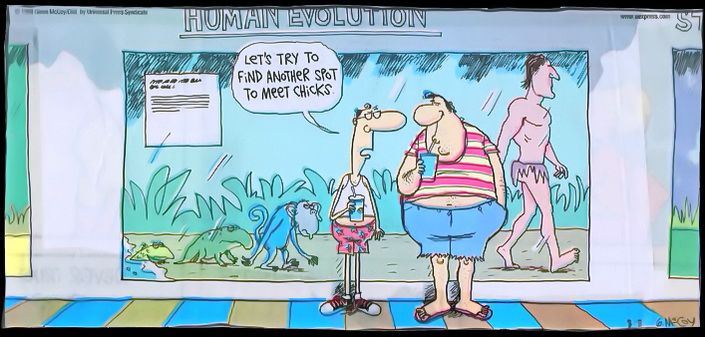
Question:
What happens when you publish a peer-reviewed paper that states inconvenient facts against Darwinism? Better yet, photos (see near bottom, click to enlarge) that cast doubt on prevailing paradigms.
You get fired.
…UPDATE (Oct 1st, 2016)
Just to recap this case before the good news:
…In February 2013, he published his findings in Acta Histochemica, a journal of cell and tissue research (M. H. Armitage and K. L. Anderson Acta Histochem. 115, 603–608; 2013). Two weeks later, he was fired from his job at California State University, Northridge (CSUN), where he managed the biology department’s electron and confocal microscopy suite.
Now he is embroiled in a long-shot legal fight to get his job back. In July, his lawyers filed a wrongful-termination suit claiming that religious intolerance motivated the dismissal: as a young-Earth creationist, Armitage says that finding soft tissue in the fossil supports his belief that such specimens date to the time of the biblical flood, which he puts at about 4,000 years ago.
The suit alleges that faculty members hostile to Armitage had him fired because they could not stand working with a creationist who had been published in a legitimate scientific journal. He and his attorneys at the Pacific Justice Institute, a conservative legal organization based in Sacramento, California, that focuses on religious and family issues, have repeatedly made that claim in the press. But specialists in US labour law suggest that his claim of religious intolerance might have difficulty standing up if the case goes to trial.
In recent years, a schoolteacher, academic and NASA employee who were creationists have claimed that they were fired unjustly for their religious beliefs. (None were reinstated.) But what makes this case different is that Armitage managed to survive for years in a mainstream academic institution and to publish research in a respected peer-reviewed journal….
(NATURE ~ See also: THE COLLEGE FIX)
Well, the court ruled in Dr. Armitage’s favor (Dr. Armitage posted this video Oct 1st, 2016):
BACK TO ORIGINAL POST…
Mark Hollis Armitage
Kevin Lee Anderson
Department of Biology, California State University, 18111 Nordhoff Street, Northridge, CA 91330-8303, USA
Abstract
Soft fibrillar bone tissues were obtained from a supraorbital horn of Triceratops horridus collected at the Hell Creek Formation in Montana, USA. Soft material was present in pre and post-decalcified bone. Horn material yielded numerous small sheets of lamellar bone matrix. This matrix possessed visible microstructures consistent with lamellar bone osteocytes. Some sheets of soft tissue had multiple layers of intact tissues with osteocyte-like structures featuring filipodial-like interconnections and secondary branching. Both oblate and stellate types of osteocyte-like cells were present in sheets of soft tissues and exhibited organelle-like microstructures. SEM analysis yielded osteocyte-like cells featuring filipodial extensions of 18–20 μm in length. Filipodial extensions were delicate and showed no evidence of any permineralization or crystallization artifact and therefore were interpreted to be soft. This is the first report of sheets of soft tissues from Triceratops horn bearing layers of osteocytes, and extends the range and type of dinosaur specimens known to contain non-fossilized material in bone matrix.
From Logos Research Associates
….In 2005, Dr. Mary Schweitzer of North Carolina State University published a ground breaking discovery (see article 1). She and her team of researchers dissected a fossilized Tyrannosaurus rex femur to find inexplicably preserved bone marrow. Two things made this unearthing astounding. First, if the fossils are really millions of years old, they should be completely fossilized by now. Fossilization is the process in which original boney material is replaced by hard minerals. However, in this case, the soft inner parts of the bone were found unfossilized with intact bone marrow. The marrow consisted of soft tissues and intact blood vessels that maintained their elasticity. This is incredible! How could soft, stretchy tissues be preserved in dinosaur remains that evolutionists claim are no younger than 65 million years old? Even in the best state of bone preservation, the soft inner parts should have completely rotted away long ago.
Dr. Schweitzer’s breakthrough publication almost a decade ago has set the stage for additional investigations by many other scientists (see article 2, 3, 4). Since then, the discovery of soft tissues in dinosaur bones has become fairly common (even among different dinosaur species) demonstrating these are not just rare exceptions or anomalies. The latest dinosaur soft tissue finding was a Triceratops specimen found at the Hell Creek formation of Montana by well-published microscopist and former instructor at California State University, Mark Armitage and his colleague Dr. Kevin Anderson of Arkansas State University (see article 5). Their analysis of a Triceratops’ horn showed that it contained original bone, soft tissue, and even complete and exquisitely preserved “bone-building” cells called osteocytes.
As in the case of Schweitzer’s T. rex fossil (see article 1) and other dinosaur soft tissue discoveries like it (see article 2, 3, 4), all the original tissue, both hard and soft, should have wholly disappeared, due either to decay, or to mineral replacement if these bones were millions of years old. The original bone has, however, been preserved down to the most minute detail, as has the soft tissue running through it, including intact blood vessels. As with Dr. Schweitzer’s findings, these tissues were elastic and flexible. Armitage’s research produced breath-taking high resolution micrographs of osteocytes—the tiny cells which, when living, repair and maintain the bone. These detailed micrographs are comparable to those taken of modern bones. (Permission to display published photographs is pending).
Regrettably, those whose worldview requires that dinosaurs lived millions of years are very eager to dismiss the evidence of soft dinosaur tissue (see article 6), but the evidence is now coming from many different scientists (see above links), who are studying a diversity of dinosaurs bones, and publishing in numerous, prestigious scientific journals. Even more disturbing than the attempts to dismiss or discredit the work of these researchers, some of these people are lashing out at the scientists who are making these discoveries. We are very saddened and disturbed to report that Mark Armitage was fired from his position at California State University just days after his paper was published on line. Please pray for Mr. Armitage….
See Also: Cocktails! C14, DNA, collagen in dinosaurs indicates geological timescales are false ~ Photos w/ descriptions below (click to enlarge):
Dinosaurs and the Bible
This article was thanks to the CARM forum/discussion board and can be found in an ENN – Article.
Most complete new giant dinosaur found in Patagonia
RIO DE JANEIRO (Reuters) – Brazilian and Argentine paleontologists have discovered the largely complete fossil of a new species of giant dinosaur that roamed what is now northern Patagonia about 80 million years ago.
The herbivorous Futalognkosaurus dukei measured an estimated 105 feet to 112 feet from head to tail and was as high as a four-storey building. It is one of the three biggest dinosaurs yet found in the world.
[….]
The find pointed to a new lineage of titanosaurs, with particularly bulky necks, he said.
“Its neck was very big in diameter, strong and huge.”
Fossilized remains of an ecosystem from the same Late Cretaceous age, including well-preserved leaves and fish, were also found. The description was published in the latest issue of the annals of the Brazilian Academy of Sciences.
[….]
“The accumulation of fish and leaf fossils, as well as other dinosaurs around the find, is just something fantastic. Leaves and dinosaurs together is a great rarity,” he told Reuters. “It’s like a whole lost world for us.”
He was referring to “The Lost World” by Arthur Conan Doyle, a classic tale set in a remote part of South America where a scientific expedition finds dinosaurs still roaming an isolated plateau.
Some of the leaves made part of the diet of the titanosaur and other specimens found there. The researchers said the fossilized ecosystem pointed to a warm and humid climate in Patagonia, which had forests during the Late Cretaceous period. The area is steppe-like now and almost bare of vegetation.
Researchers believe the carcass of the giant dinosaur, which died of unknown causes, its flesh devoured by predators, was washed into a nearby slow-flowing river, where it created a barrier, accumulating bones and leaves in its structure for many years until all became fossilized.
A fossil of a carnivorous theropod Megaraptor found at the site contained a complete and articulated arm with very large sickle-shaped claws. Previously, similar fragmented bones were interpreted as a foot, researchers said.
The joint Argentine-Brazilian project also works in the Brazilian state of Mato Grosso, where Kellner said an important find has been made but would be revealed at a later date.
Desert-like areas in Argentina are good for preserving fossils, while they are more difficult to find in the wetter soil in Brazil.
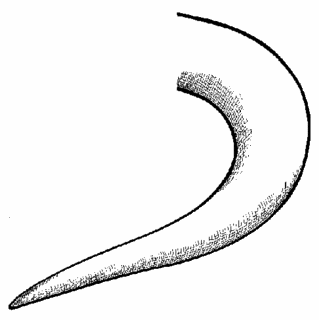
There are a few things I take issue with here, but they are minor. Every fossil find involves a river or a local FLOOD. I just love it as a Young Earth Creationist (YEC) to hear this because it confirms in a major way historical and Biblical accounts of a FLOOD. Again, ALL the fossils found are in flood deposits. Okay, let play a game. The game is “Pin the Tail on the Donkey.”
Except we don’t have a donkey, but I’m sure you can figure it out. We have three creatures needing a tail:
Of course, you are probably wondering why I am displaying these comical pictures, and what — if anything — these pictures have to do with dinosaurs and the Bible! Let me explain. The ancient record of a man named Job is found in the Bible. It goes back to a time over 2,000 years before Christ. The fascinating story of Job is one of the oldest pieces of literature on earth. It was written down just a few hundred years after the flood of Noah’s time. In the 40th chapter of Job’s account, we see the record of the Creator Himself speaking to job. He is drawing Job’s attention to one of the wonders of the creation. Let’s read it.
“Look now at the behemoth, which I made along with you…” (verse 15)
Behemoth in the Hebrew simply means large beast. Most bibles have a marginal note by this verse explaining that this creature was most likely an elephant or hippopotamus (half of the above drawings explained!). God is saying to Job, “take a good look at this creature. I am going to demonstrate something to you.”

Now we have a problem (and the answer to the drawings above). Have you noticed something distinctive about cedar trees?
They are big aren’t they? Now have you seen a tail of an elephant or a hippo? It doesn’t seem that a cedar tree is a very appropriate analogy does it. Let’s re-read – and finish – the verses of study.
Now, I know you are thinking to yourself, “Flood!? Noah!? Bible!? Dinosaurs and man co-existing is outrages by evolutionary terms, I mean, dinosaurs died out at least 64 million years ago! And man didn’t show up on the evolutionary scene till about 1 to 4 million years ago (depending on what evolutionary tree you accept).” Yes, I know this sounds incredible, but some amazing items from history and archaeology are mounting the evidence against this belief that man and dino are separated by massive amounts of time and geological layers. [As hinted at above and below.]
Job 40: 15-24 (KJV)
15 Behold now behemoth [large beast], which I made with thee [all animals and Adam and Eve were created on the sixth day]; he eateth grass as an ox [vegetarian].
16 Lo now, his strength [is] in his loins [large, powerful legs], and his force [is] in the navel of his belly [large mid-section.]
17 He moveth his tail like a cedar [huge tail]: the sinews of his stones are wrapped together.
18 His bones [are as] strong pieces of brass [big bones]; his bones [are] like bars of iron [again, big bones].
19 He [is] the chief of the ways of God [largest or mightiest creation]: he that made him can make his sword to approach unto him [only God can kill him].
20 Surely the mountains bring him forth food, where all the beasts of the field play.
21 He lieth under the shady trees, in the covert of the reed, and fens [we have all seen drawings of these beasts halfway in the water with their head up eating the vegetation on the sides of the banks].
22 The shady trees cover him [with] their shadow; the willows of the brook compass him about [again, in a swamp, or the like].
23 Behold, he drinketh up a river, [and] hasteth not: he trusteth that he can draw up Jordan into his mouth [the NASB says in v. 23: “if a river rages, he is not alarmed. He is confidant, though the Jordan rushes to his mouth”].
24 He taketh it with his eyes: [his] nose pierceth through snares [you cannot catch him].
Here is a paraphrase/adaptation of the above verse:
Although the monstrous creature was obviously a vegetarian, its size was overwhelming. Its hips were built to withstand the enormous force of each pounding step and its midsection was a mass of muscle. Its gigantic tail extended far behind, not unlike a giant cedar tree swaying behind his body. Its bones were built like steel girders with ribs like iron bars to support his enormous weight. Surely this was the greatest among the creatures ever to roam the swamps and rivers of the earth. (Creation.com)
Fresh Duckbill Dinosaur Bones
Newest Discover of soft-dinosaur bones found (click to enlarge):
Actually, soft bones coming from these areas in Alaska are nothing new… but since the famous T-Rex find, it has become kosher to admit them.
Most people think that all known dinosaur bones are fossils, and that this proves dinosaurs died out millions of years ago. Yet “fresh”, unfossilized, dinosaur bones have been found, suggesting that dinosaurs might have lived recently.
In northwestern Alaska in 1961 a geologist found a bed of dinosaur bones in unpermineralized (“unfossilized”) condition. In another case, a young Inuit (Canadian Eskimo) who was working with scientists from Newfoundland’s Memorial University in 1987 on Bylot Island found part of a lower jaw of a duckbill dinosaur. It too was in fresh condition. Here is a portion of an article on this:
The lady was highly skeptical. This guide, who moments before had been discussing animal ecology and evolution, found when confronted with news of the new discovery—that she simply could not believe it. She could not accept that fresh (not permineralized, meaning unfossilized) dinosaur bones had been found in Alaska. Such bones could never have lasted 70 million years, she said.
Unlikely or not, it is a fact that such bones have been found. However, whether they could have lasted in that condition more than a few thousand years is a matter which demands attention.
In 1987, while working with scientists from Memorial University (Newfoundland, Canada) on Bylot Island, just east of the northern tip of Baffin Island, a young Inuit (Canadian Eskimo) picked up a bone fragment. It was identified within days as part of the lower jaw of a duckbill dinosaur and proclaimed to the world as such.1
The story was different however in north-western Alaska. In 1961 a petroleum geologist discovered a large, half-metre-thick bone bed. As the bones were fresh, not permineralized, he assumed that these were recent bison bones. It took 20 years for scientists to recognize duckbill dinosaur bones in this deposit as well as the bones of horned dinosaurs, and large and small carnivorous dinosaurs. Presently William A. Clemens and other scientists from the University of California at Berkeley and the University of Alaska are quarrying the bone bed.2 ….
1. Accounts of this appeared in the popular press, such as in the Edmonton Journal, October 26, 1987, a few months after the event, and in Saturday Night (a monthly magazine of analysis of current events) in August 1989, Vol.104 No.8, pp.16-19.
2. An initial announcement was printed in l985 in Geological Society of America abstract programs Vol.17, p.548. Already in press at that time was an article describing the site and the condition of the bones (Kyle L. Davies, ‘Duck-bill Dinosaurs (Hadrosauridae, Ornithischia) from the North Slope of Alaska’, Journal of Paleontology, Vol.61 No.1, pp.198-200.
The journal Science on December 24, 1993 (pages 2020–2023) reported on the amazing preservation of the bones of a young duckbill dinosaur found in Montana. Under a microscope, the fine structure of the bones was seen to have been preserved to such an extent that cell characteristics could be compared with cells of chicken bone. Claudia Barreto and others said, “In the dinosaur specimens, the same high degree of structural resolution can be seen as in modern specimens.” Even the calcium and phosphorus ratios were comparable. In other words, these appeared to be fresh bones, not fossilized — even though they are claimed to be more than 70 million years old.
Such findings cast serious doubt on the millions of years claimed for the dinosaurs.
Michael Cremo’s Take
A lot of UFO enthusiasts have latched onto Michael’s work. He is of Hindu influence and mentions that the Vedas mention that civilization has been on earth for millions of years. So, a young-earth creationists will look at the same evidence as Dr. Cremo and use IT to bolster the idea that all the animals of the earth were created by the sixth-day of Creation. Here is a short interview of Dr. Cremo on the matter. One should know he is the author of “Forbidden Archaeology“
So, we know — essentially — that Michael Cremo is a new ager… but, we can use the same evidence to show that: “yes, the young earth creationist viewpoint is concurrent with archaeological finds showing that the Hebrew Scripture is correct — man and dinosaur co-existed.” I combined two parts into one video showing an example of one of the oldest evidences of man living in the Cambrian age. As mentioned before, some take the same evidence as examples of the earth being visited by aliens. A great clip either way to show that current theories are off by millions of years:
The Bell Tomb
One of the best sites to follow up on the below are here. So what is the Bell Tomb? Apologetic Press explains a bit:
Yet, consider, for example, the evidence provided by the Bell tomb engravings. In far northern England, near the Scottish border, lies the village of Carlisle. A city with a turbulent history, the Romans built a wall through it, the Vikings invaded it, and the Scots and English fought over it for many years. Located in this English village is the medieval-period Carlisle Cathedral which was founded in A.D. 1122 by King Henry I (“Visit Cumbria…,” n.d.).
On February 11, 1478, Richard Bell was elected Bishop of the Carlisle Cathedral, and served some 17 years before resigning on September 4, 1495. He died in 1496 at the age of 86 and,in keeping with British custom, was buried beneath the floor in the cathedral’s choir (Priory and Raines, p. xxviii). The tomb is now covered by a carpet, to prevent any further effacing of the engravings caused by the human foot traffic of many centuries.
The monumental slab is beautifully inlaid with brass, including the facade of the cathedral in outline relief above and to each side of a solid image of the bishop himself, coupled with a solid strip of brass beneath the bishop. The following image is taken from Hutchinson’s 1794 volume The History of the County of Cumberland (p. 602b)…
[….]
A narrow strip of brass (9½ feet long) that runs around the outer edge of the tomb cover slab bears Latin words translated:
Here lies the Reverend Father Richard Bell sometime Bishop of Carlisle who departed from this life the twenty-forth [sic] day, in the year of the Lord. Among all the faithful departed through the mercy of God may he rest in perpetual peace. Amen (Weston, p. 62).
Interspersed among these Latin words are engravings of a human face, the trinity, and some 18 animals—a veritable “zoo.” Look carefully at these most intriguing engravings…
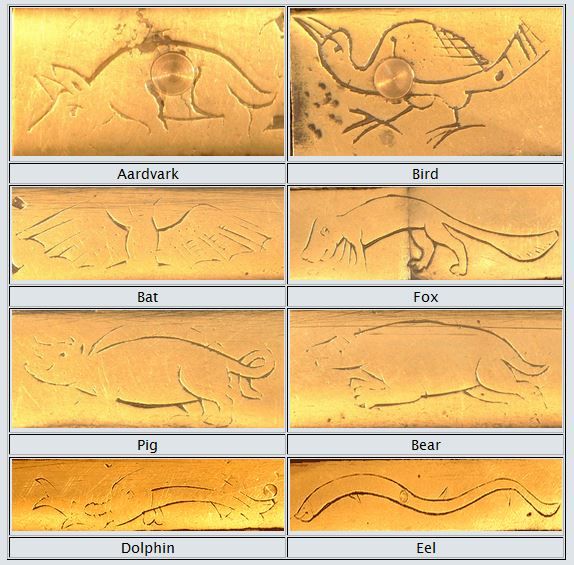

Here is the portion of interest to a-holes like myself:
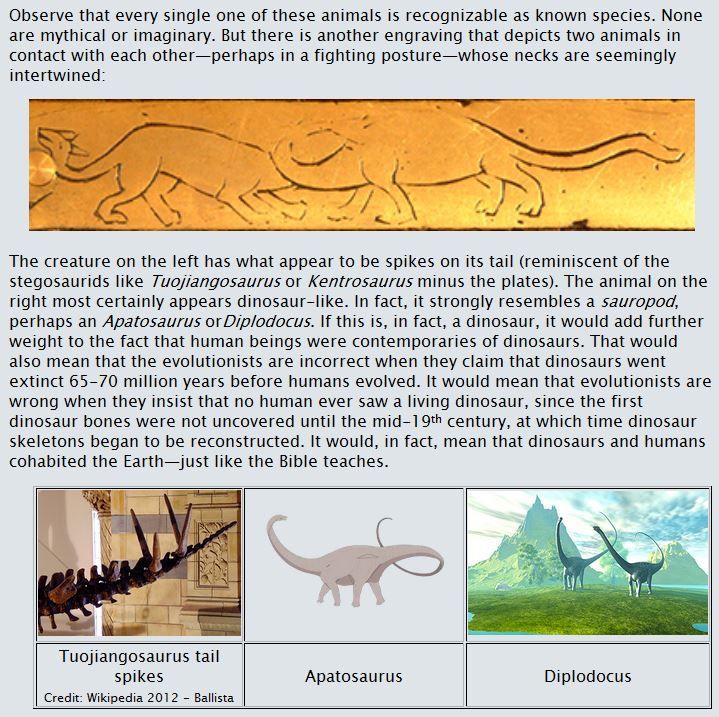
Here is a digitizing of the lines to show them as they originally appeared, from Vance Nelson, Untold Secrets of Planet Earth: Dire Dragons (Red Deer, Alberta Canada: Untold Secrets Publisher, 2013), 62:
The Delk [& Other] Track
At a site that responds to critics about the Delk Track, we get a bit of a background of the print:
In July of 2000, Alvis Delk was wandering through the Paluxy river, in Glen Rose, Texas, when he flipped over a slab of rock which contained a pristine fossil dinosaur track. These tracks are common in the area, and he took it home for a keepsake.
It sat in his living room for eight years.
Sadly, in 2007, he had a bad accident which left him hospitalized for quite some time. When he got home, he needed money to pay off his medical bills, and began to clean off the dinosaur track in hopes that he could perhaps fetch a few hundred dollars for it.
This is when he discovered that was also a fossil human footprint in the rock, still covered under dried clay.
This find has profound ramifications for the Creation/Evolution debate. Evolutionary scholars have admitted that if dinosaurs and humans lived together in the past, then this completely destroys the theory of evolution.
The slab was purchased by the Creation Evidence Museum of Glen Rose, Texas. It was photographed and documented by David Lines, and molded by Dough Harris, Daniel Elif, and myself.
There has been fraud to come out of this area, but the track in question has been Cat-Scanned, unlike the other instances of fraud: 
…In August 2008 the granddaughter of one of the townsfolk who first sold the footprints admitted that her grandfather had carved the human footprints as a means of making money during the depression. No one was surprised. (Update: to be fair, Morris was aware in the 1970s that forgeries had been made by a local trickster. Surprisingly, that did not cause him to question the entire enterprise, or the veracity of eyewitness testimony.)
What is fascinating about this story is that he did not carve the tracks, only the prints that were sold. Creationists were so biased by their perspective that the carved prints tricked them into believing that what they were seeing in the river bed, even though some of the prints were outlandishly large, had to be human….
So this is why the Delk Track stands out. Here is a short video explaining the track:
And the bias of these kind of prints is shown in the assumptions made by evolutionists themselves. One main one being with the Laetoli Footprints… which is: if you remove the evolutionary assumptions, there is very little reason to think that the footprints were made by any creature other than man. And this is the whole idea of this post. One site makes these points:
Even Mary Leakey and her team were amazed “at how very human they were” (Ancestral Passions, p. 486).
Tim White, who was involved in excavating the prints, said:
“They are like modern human footprints. If one were left in the sand of a California beach today, and a four-year-old were asked what it was, he would instantly say that someone had walked there. He wouldn’t be able to tell it from a hundred other prints on the beach, nor would you. The external morphology is the same. There is a well-shaped modern heel with a strong arch and a good ball of the foot in front of it. The big toe is straight in line. It doesn’t stick out to the side like an ape toe, or like the big toe in so many drawings you see of Australopithecines in books” (Johanson and Edey, Lucy: The Beginnings of Humankind, p. 250).
Melvin Lubenow says:
“Interpreting the Laetoli footprints is not a question of scholarship; it is a question of logic and the basic rules of evidence. We know what the human foot looks like. There is no evidence that any other creature, past or present, had a foot exactly like the human foot. We also know what human footprints look like. But we will never know for sure what australopithecine footprints look like, because there is no way of associating ‘beyond reasonable doubt’ those extinct creatures with any fossil we might discover” (Bones of Contention, p. 331).
Russell Tuttle of the University of Chicago did an extensive study of habitually unshod people in the mountains of Peru to use in comparison with the Laetoli footprints. He argued that they “resemble those of habitually unshod modern humans” (“The Pitted Pattern of Laetoli Feet,” Natural History, March 1990).
Dr. Duane Gish observes that since footprints of antelopes, pigs, giraffes, elephants, rhinos, hares, ostriches, and other non-extinct animals were also found at Laetoli, that there is no reason to think that the prints were that of anything other than modern man. “In artists’ conceptions of the scene, we see pictures of giraffes for the giraffe footprints, elephants for the elephant footprints, ostriches for the ostrich footprints, etc. And–humans for the human footprints? Oh, no! Occupying the human footprints we see a sub-human creature, half-ape and half-man. While evolutionists concede that a giraffe must have made the giraffe prints, an elephant must have made the elephant prints, etc., their preconceived ideas about evolution and the age of these formations do not allow them to concede that a human made the human prints. Creationists, accepting the plain facts as revealed by the empirical scientific evidence, believe that the prints were made by modern man–Homo sapiens” (The Fossils Still Say No, p. 276).
Two VERY quick bios of the prints are as follows. Keep in mind the only proof that this was not man making the print is an artistic drawing:
Video description:
In 1978, a team led by Mary Leakey discovered a series of footprints in Tanzania. These are known as the Laetoli footprints. According to many researchers, these footprints are identical to those made by humans. Paleoanthropologist, Donald Johanson stated, ‘Make no mistake about it, they are like modern human footprints’.
Why is it, then, that most scientists reject the idea that humans made these footprints? To understand this odd situation, it’s important to realize that evolutionists think that the footprints were made in mud 3.6 million years ago. Therefore, according to such evolutionary ideas, humans weren’t around then, so the footprints can’t be human! But if a human didn’t make the footprints, who or what did? A Scientific American article acknowledges that this is still an ‘unsolved mystery’ . However, I can’t help but feel it’s a mystery of their own making, caused by their evolutionary thinking, instead of taking the Bible’s history seriously.
Related Articles:
This second video is by Dr. Marc Surtees who has a degree in Applied Biology and a PhD in Zoology.
Radioactive Dating Introduction
And here are, for the curious, a great presentation (which I broke up into each assumption for ease of consumption) dealing with dating methods and there problems for dating the earth in long ages:
Intro: What Is Radioactive Dating & Its Assumptions?
Evidence 1: Challenging Assumptions In Radioactive Decay Rate
Evidence 2: Challenging Assumptions In Radioactive Decay Rate
Evidence 3: Challenging Assumptions In Radioactive Decay Rate
Evidence 4: Challenging Assumptions In Radioactive Decay Rate
Evidence 5: Challenging Assumptions In Radioactive Decay Rate
Just A Couple Documentaries
One of my favorite short documentaries about Geology (below). Guy Berthault discusses some evidences from deep sea drilling, deposits at the mouths of rivers, and work done in concert with hydrologists at the Colorado State University hydraulics laboratory at Fort Collins.
I highly recommend watching these two short videos:
★ Geo-Blunder: No “Millions of Years”! – 3minutes
★ Fossils in Layers Made By Mt. St. Helens – 4minutes
Below video:
“Guy Berthault uses laboratory and sediment flume experiments to test accepted principles for the formation of strata. He shows, using easy to follow computer animation, that in moving currents several of the basic principles of stratigraphy do not apply. These principles, including the principles of superposition and continuity, are applicable only in calm water. He applies flume experiments to the real world of strata, mainly the formation of the layers in the Grand Canyon. Long periods of time are not required to deposit a sequence of strata in a moving current, and multiple beds can be deposited simultaneously, especially as a result of changing current speeds. His results have profound implications for the geological column and the interpretation of fossil sequences.”

This post is a response to the Word Faith teacher, Jesse Duplantis, but also to skeptics of Biblical history. This post is an updated version to the one I posted at The WORD on the Word Faith Movement a long time ago. As with other matters of faith Jesse is wrong in this matter — both in his use of Biblical text as well as his history.
Saddam Hussein was also obsessed with this history, as this article shows.
The Greek historian, Herodotus, about 500 B.C., described the structure, which then consisted of a series of eight ascending towers, each one recessed in turn, with a spiral roadway running around it as a means of climbing to the top.
Babylonian legend (of which we’ll get to) asserted that it had originally been built by Nimrod, which coincides with the Biblical record. In fact, the region, about ten miles southwest of Babylon’s center is still called Birs Nimroud. The structure as Herodotus described it was more than seven hundred feet tall, of which three hundred feet remain to this day.
The descendants of Noah built this tower. The list of primeval nations in Genesis 10, “the Table of Nations”, is by far the most complete and accurate listing of the tribes and nations of antiquity. One of the world’s greatest archaeologists, William F. Albright, called it “an astonishingly accurate document.” It lists the descendants of Shem, Ham, and Japheth (the three sons of Noah) and indicates what regions they settled. (For an excellent book that is free online in its entirety, I recommend: After the Flood.) Many historical documents from many cultures trace back their ancestry to these three “sons of Noah.” The ziggurats, and pyramids, and bow & arrow, as well as boomerangs being used and built by every culture on every continent is a hint to mankind all living together at one time; and having common technology.
LANGUAGE
Many scientists who study the origin of languages, known as philologists, have concluded that it is probable that the thousands of dialects and languages can be traced back to an original language in man’s ancient past. Professor Alfredo Trombetti (Italian linguist) claims that he can prove the common origin of all languages. Max Mueller, one of the greatest oriental language scholars, declared that all human languages can be traced back to one single oriental language. Chinese is the most ancient (although probably not the original [root] language), fully recorded, still used, language around, going back to over 3,000 years ago.
Scientific American notes the history of all languages coming from a single source when they note that languages “as diverse as English, Russian and Hindi can trace their roots back more than 8,000 years to Anatolia — now in modern-day Turkey.” Scientific American continues:
That’s the conclusion of a study that assessed 103 ancient and contemporary languages using a technique normally used to study the evolution and spread of disease. The researchers hope that their findings can settle a long-running debate about the origins of the Indo-European language group.
English, Dutch, Spanish, Russian, Greek and Hindi might all sound very different, but there are many commonalities, such as the Dutch moeder, Spanish madre and Russian mat’, all of which mean “mother”. On this basis, researchers have concluded that more than a hundred languages across Europe and the Middle East, from Iceland to Sri Lanka, stem from a common ancestor.
True Origins, a site dedicated in-large-part to responding to Talk Origins, notes that many evolutionary theories/theorists postulate a single source for all our languages,
Many evolutionary linguists believe that all human languages have descended from a single, primitive language, which itself evolved from the grunts and noises of the lower animals. The single most influential “hopeful monster” theory of the evolution of human language was proposed by the famous linguist from MIT, Noam Chomsky, and has since been echoed by numerous linguists, philosophers, anthropologists, and psychologists. Chomsky argued that the innate ability of children to acquire the grammar necessary for a language can be explained only if one assumes that all grammars are variations of a single, generic ‘universal grammar’, and that all human brains come “with a built-in language organ that contains this language blueprint.”
See a creationist take on this, here.
Ancient History 101
The French government sent Professor Oppert to report on the cuneiform inscriptions discovered in the ruins of Babylon. Oppert translated a long inscription by King Nebuchadnezzar in which the king referred to the tower in the Chaldean language as Barzipp, which means “Tongue-Power.” The Greeks used the word Borsippa, with the same meaning of Tongue-power, to describe the ruins of the Tower of Babel. This inscription of Nebuchadnezzar clearly identified the original tower of Borsippa with the Tower of Babel described by Moses in Genesis. King Nebuchadnezzar decided to rebuild the base of the ancient Tower of Babel, built over sixteen centuries earlier by Nimrod, the first King of Babylon.
Nebuchadnezzar rebuilt the city of Babylon in great magnificence with gold, silver, cedar, and fir, at great cost on top of a hard surface of baked clay bricks. These bricks were engraved with the seal of Nebuchadnezzar. At the base of the Tower of Babel is this inscription by King Nebuchadnezzar that, in his own words from thousands of years ago, confirm one of the most amazing events of the ancient past.
Here is a picture (right) from a newly discovered find Discovery Channel notes in their “archaeology” section:
A team of scholars has discovered what might be the oldest representation of the Tower of Babel of Biblical fame, they report in a newly published book.
Carved on a black stone, which has already been dubbed the Tower of Babel stele, the inscription dates to 604-562 BCE.
It was found in the collection of Martin Schøyen, a businessman from Norway who owns the largest private manuscript assemblage formed in the 20th century.
Consisting of 13,717 manuscript items spanning over 5,000 years, the collection includes parts of the Dead Sea Scrolls, ancient Buddhist manuscript rescued from the Taliban, and even cylcon symbols by Australia’s Aborigines which can be up to 20,000 years old.
The collection also includes a large number of pictographic and cuneiform tablets — which are some of the earliest known written documents — seals and royal inscription spanning most of the written history of Mesopotamia, an area near modern Iraq.
[….]
“Here we have for the first time an illustration contemporary with Nebuchadnezzar II’s restoring and enlargement of the Tower of Babel, and with a caption making the identity absolutely sure,” the Schøyen Collection stated on its website.
Take note even “bar-tabs” were discussed from the time.
THE INSCRIPTION
“The tower, the eternal house, which I founded and built. I have completed its magnificence with silver, gold, other metals, stone, enameled bricks, fir and pine. The first which is the house of the earth’s base, the most ancient monument of Babylon; I built and finished it. I have highly exalted its head with bricks covered with copper. We say for the other, that is, this edifice, the house of the seven lights of the earth the most ancient monument of Borsippa. A former king built it, (they reckon 42 ages) but he did not complete its head. Since a remote time, people had abandoned it, without order expressing their words. Since that time the earthquake and the thunder had dispersed the sun-dried clay. The bricks of the casing had been split, and the earth of the interior had been scattered in heaps. Merodach, the great god, excited my mind to repair this building. I did not change the site nor did I take away the foundation. In a fortunate month, in an auspicious day, I undertook to build porticoes around the crude brick masses, and the casing of burnt bricks. I adapted the ciruits, I put the inscription of my name in the Kitir of the portico. I set my hand to finish it. And to exalt its head. As it had been done in ancient days, so I exalted its summit.”
(See more at WIKI, and, Bible Probe)
This inscription was translated by Professor Oppert. In addition, Mr. William Loftus translated this fascinating inscription in his book, Travels and Researches in Chaldea and Sinai. This incredible inscription confirms the Biblical accuracy of one of the most fascinating stories in the Book of Genesis.
Wikipedia gets in on the action as well:
…The Tower of Babel has been associated with known structures according to some modern scholars, notably the Etemenanki, a ziggurat dedicated to the Mesopotamian god Marduk by Nabopolassar, king of Babylonia (c. 610 BCE). The Great Ziggurat of Babylon was 91 metres (300 ft) in height. Alexander the Great ordered it demolished circa 331 BCE in preparation for a reconstruction that his death forestalled. A Sumerian story with some similar elements is told in Enmerkar and the Lord of Aratta…
The pagan king Nebuchadnezzar confirms in his own words the incredible details that a “former king built it, but he did not complete its head,” confirming the truthfulness of the Genesis account that God stopped the original builders from completing the top of the Tower of Babel. Most significantly, King Nebuchadnezzar’s inscription declares that the reason the original king could not complete the tower was because, “Since a remote time, people had abandoned it, without order expressing their words.” In other words, they lost the ability to control their language and communication!
Compare the statement of Nebuchadnezzar, “A former king built it, but he did not complete its head. Since a remote time, people had abandoned it,” with the words of Moses in Genesis 11:7; “So the Lord scattered them abroad from there over the face of all the earth, and they ceased building the city.” Even more startling is the phrase of the pagan king where he declared that the reason they could not complete the top of the “Tongue-tower” was that the “people had abandoned it, without order expressing their words.”
CONCLUSION
NON-GOD HISTORY SHOWS:
Tower of Babel a real place;
✦ Herodotus confirms;
✦ Alexander the Great’s historians confirm;
✦ Cuniform discoveries support as well (found in the collection of Martin Schøyen as one example).
DESTRUCTION
✦ Non-Biblical archaeology shows that there was an event dealing with its destruction.
LANGUAGES
✦ Non-Biblical archaeology shows that there was an event at the Tower dealing with language;
✦ Ancient Chinese history also support this idea.
LANGUAGES COME FROM A SINGLE SOURCE
✦ Linguists support this
✦ Science journals support this
This equals a pretty amazing “coincidence” in my book. Biblical History is wonderfully rich.
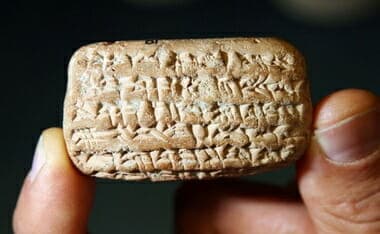
(See the Poached Egg a year back)
Working at the British Museum, Assyriologist Michael Jursa has made a breakthrough discovery whilst examining a small clay tablet with a Babylonian cuneiform inscription. The document is dated to the 10th year of Nebuchadnezzar II (595 BC). It names a Babylonian officer, Nebo-Sarsekim, who according to chapter 39 of the Book of Jeremiah was present at the siege of Jerusalem in 587 BC with Nebuchadnezzar himself. The tablet thus confirms the historical existence of the Biblical figure. Evidence from non-Biblical sources for individuals named in the Bible other than kings is incredibly rare
Nebo-Sarsekim is described in the book of Jeremiah as ‘chief eunuch’ (as the title is now translated, rather than ‘chief officer’). The Babylonian tablet proves that his name was really pronounced as Nabu-sharrussu-ukin, and gives the same title, ‘chief eunuch,’ in cuneiform script, thereby confirming the accuracy of the Biblical account.
The discovery highlights the importance of the study of cuneiform. The British Museum’s collection contains well over one hundred thousand inscribed tablets which are examined by international scholars on a daily basis. Reading and piecing together fragments is painstaking and slow work, but cuneiform tablets are our only chance of obtaining knowledge of this fateful period of human history. Other discoveries made whilst examining tablets include an Assyrian version of the Old Testament flood story, observations of Halley’s Comet and even rules for the world’s oldest board game.
Dr Jursa, Associate Professor of the University of Vienna, has been studying tablets at the British Museum since 1991. He says of this discovery:
“Reading Babylonian tablets is often laborious, but also very satisfying: there is so much new information yet to be discovered. But finding something like this tablet, where we see a person mentioned in the Bible making an everyday payment to the temple in Babylon and quoting the exact date is quite extraordinary.”
Irving Finkel, Assistant Keeper in the Department of the Middle East at the British Museum, commented: “Cuneiform tablets might all look the same, but sometimes they contain treasure. Here a mundane commercial transaction takes its place as a primary witness to one of the turning points in Old Testament history. This is a tablet that deserves to be famous.’
h/t to the members at The Christian Apologetics Alliance andQuite Time Thoughts
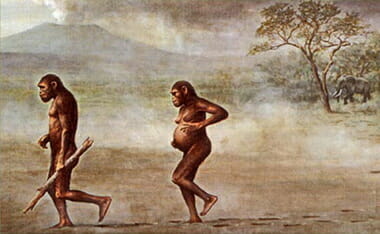
So you can see JUST how arbitrary historical science is (Darwinian evolution in this case), scientists have just doubled the age of man, via Creation Research Society’s, Creation Matters newsletter (July/Aug 2014, Volume 19, Number 4) ~ “Your Inner Ape Just Got Older”:
Evolutionists have doubled their date of the chimp-human split from 7 million to 13 million years ago. How, and why? National Geographic announces gleefully, with a picture of a chimp playing with a child, “Ancient Human-Chimp Link Pushed Back Millions of Years.”1 Based on a study of chimp genes in Science,2 …
[….]
The new estimate is based on current mutation rates in the sample, but a lead author confessed, “We also don’t know if mutation rates varied widely in the ancient past; maybe they were different than now.”
1. Vergano, D. (2014, June 12) Ancient human-chimp link pushed back millionsof years: Older male chimps sped evolution and reset era of our last commonancestor with apes. National Geographic Daily News. Retrieved June20, 2014 from http://news.nationalgeographic.com/news/2014/06/140612-chimp-father-evolution-human-science/
2. Venn, O., I. Turner, I. Mathieson, N. de Groot, R. Bontrop, and G. McVean.2014. Nonhuman genetics. Strong male bias drives germline mutation inchimpanzees. Science 344(6189):1272–1275.
Two observations… the first one being in a form of a question:
I argue it cause less confidence. Why? — you so astutely ask. This is why: ALL the evidences and previous timelines based on a wide variety of work from archaeology, paleontology, and dating methods used to date man’s time-table… are thrown out. Why does science, so called, make such giant leaps (remember that the age of the Virgo Cluster being essentially chopped in half?)? Because the previous evidence is shoddy, and very, very subjective.
The second commentary is at least an honest admission from the researchers. I wish such honesty existed in the dating community… not the dating community as in male/female. But the dating community in the radioactive measurements. Even Forbes Magazine is catching up to the idea:
One of the first things that Physics students learn when they study radioactivity is the idea of the half-life. A half-life is the period of time in which it takes one-half of a given amount of a radioactive substance to decay. Radioactive decay happens when a radioactive substance emits a particle. It’s impossible to predict exactly when a given atom of a substance will emit a particular particle, but the decay rate itself over a long period of time is constant.
Or, at least, that’s what we thought. But if physicists at Stanford and Purdue are correct in their findings, the whole theory of constant radioactive decay rates could be thrown out the door.
The story begins, as scientific discoveries often do, randomly. Literally, in this case. The team of physicists was investigating the possibility of using radioactive decay rates to generate random numbers, since the rate is constant but the emission of individual atoms is unpredictable, it seemed like a perfect fit.
Then came the problem:
As the researchers pored through published data on specific isotopes, they found disagreement in the measured decay rates – odd for supposed physical constants.
Checking data collected at Brookhaven National Laboratory on Long Island and the Federal Physical and Technical Institute in Germany, they came across something even more surprising: long-term observation of the decay rate of silicon-32 and radium-226 seemed to show a small seasonal variation. The decay rate was ever so slightly faster in winter than in summer.
Was this fluctuation real, or was it merely a glitch in the equipment used to measure the decay, induced by the change of seasons, with the accompanying changes in temperature and humidity?
As it turns out, they probably aren’t….
As you can see in my more lengthy dealing with the matter as a supplement to a men’s group at church, the assumption of continuous decay rates at the present — observable — rates applied to the past is a HUGE assumption that is not scientific at all. Here are other “icons of evolution” decunstructed:
A great magazine for all ages: click to enlarge
Here is an imported article from ICR entitled, “New Artifact Supports Antiquity of Bible.” It has to do with the applicability of real history versus history twisted with presuppositional stances:
An Israeli professor has found evidence that certain books of the Bible could easily be as old as their texts claim. Some scholars had believed that Hebrew writing did not yet exist when these books were purportedly written. But though it does not quote the Bible, a 3,000-year-old piece of pottery from Israel bears text inked in Hebrew, the language of the original Old Testament.
The pottery shard was excavated in 2008 about 18 miles west of Jerusalem, at Khirbet Qeiyafa. It was translated by Professor Gershon Galil of the University of Haifa, who determined:
It uses verbs that were characteristic of Hebrew, such as asah (“did”) and avad (“worked”), which were rarely used in other regional languages. Particular words that appear in the text, such as almanah (“widow”) are specific to Hebrew and are written differently in other local languages. The content itself was also unfamiliar to all the cultures in the region besides the Hebrew society.1
Modern critical scholars have often contended that many portions of the Bible were actually written long after the events they describe, and that the text was then attributed after the fact to the ancient authors. The conservative view that the Bible was authored by the individuals it names clashes with the liberal assertion that the people at the time were illiterate, or that the Hebrew language did not even exist then. But this newly translated artifact demonstrates that the Hebrew language was alive and well, in both spoken and written form, during the time that many portions of the Bible were written.
Fox News reported, “The inscription is the earliest example of Hebrew writing found, which stands in opposition to the dating of the composition of the Bible in current research.”2 How could “current research” have been hundreds of years off regarding its dates?
One reason that some academics have posited much later dates of authorship has been their bias against the supernatural. For example, significant prophecies were recorded by Daniel, chief advisor to several Babylonian kings, in about 536 B.C. God revealed to Daniel the number of years until the promised One, Jesus Christ, would enter Jerusalem, then be “cut off.”3 Christ fulfilled these prophecies to the exact year during His triumphal entry and crucifixion, respectively.
Since a centuries-earlier prophecy of this future event could only have occurred through a supernatural revelation, a much later date (though still over a century prior to Christ) was asserted for prophetic portions of Daniel’s book, along with the idea that Daniel was attributed false authorship after some of the prophesied events had actually occurred. For example, he foretold the rise of Alexander the Great, who unified the Greek empire in the third century BC.4
The newly deciphered Hebrew inscriptions date from the 10th century BC, long before Daniel.5 Therefore, the claim can no longer be made that much of the Bible could not possibly have been written by the listed authors because the Hebrew language did not exist until later. It is now more apparent than ever that these assertions of late-date authorship were not rooted in evidence, but in a certain ideology.
Here is a documentary that touches on many of these issues, that is naturalistic assumptions in history being proven wrong, time-and-time-again: